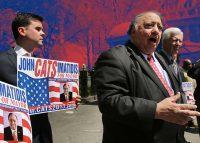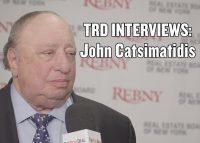When I think of Feb. 14, three things come to mind: Valentine’s Day, Amazon canceling HQ2 on that date in 2019, and the deadline for John Catsimatidis to switch parties to run for mayor as a Democrat.
I bet you didn’t predict that third one.
Even folks who are following the free-for-all that is this year’s mayoral race have given little thought to Catsimatidis — despite the media dutifully covering the Republican billionaire’s periodic musings about running.
Read more



Politico reported last week that the developer and Gristedes owner who also has interests in oil refining and insurance would soon decide whether to become a Democrat to run for mayor.
Catsimatidis’ logic, as he told Politico’s Erin Durkin, is: “With ranked choice voting in the primary, who knows what happens?”
With New York voters ranking up to three candidates on their ballots for the first time, we don’t know who will win. But we know who won’t: Catsimatidis.
I don’t mean to insult the man. He is, after all, a self-made billionaire, not to mention a graduate of test-in high school Brooklyn Tech. But he’s not so much a genius as a savant — a college dropout who parlayed ambition, intuition and luck into a $3 billion fortune.
Catsimatidis left New York University and bought a $10,000 stake in the Upper West Side 7-Eleven where he worked. He repaid the money and by age 25 he had 10 Red Apple stores.
Though he is best known for Gristedes, it was oil that made him uber wealthy.
He bought United Refining out of bankruptcy in 1986, having come across the opportunity while in bankruptcy court on an unrelated case. It made sense to own gas stations that could sell the fuel he was refining from Canada’s sludgy crude, so he bought some. He now has nearly 300 Kwik Fill and Red Apple Food Mart locations across three states.
His business skills, however, do not translate to New York politics. He spent $11.4 million in losing the 2013 Republican primary for mayor by 12 points to Joe Lhota ($6.6 million), who in turn was crushed by Bill de Blasio, 73 percent to 24 percent.
Nothing in Cats’ history suggests he will spend $75 million to $100 million of his own money on a campaign, like the much wealthier Michael Bloomberg did three times. But if he did, he would still lose.
Even before Donald Trump’s presidency, city voters had soured on Republicans, which is why Bloomberg left the party a year before his 2009 run. Hence, Catsimatidis’ idea to run as a Democrat.
“We’re just exploring it,” he told me yesterday. “We’re deciding if it makes any sense.”
Asked if he is polling to gauge his chances, Catsimatidis said, “Polling? That’s the biggest con game in the world.”
He noted that for years, he was a Bill Clinton Democrat. “I can be a conservative Democrat, or I can be a liberal Republican,” he told Durkin.
But a conservative cannot win the Democratic primary, where voters are a mix of liberals, moderates and socialists. They will not vote for someone who says, as Catsimatidis did to Durkin, that Trump “did a great job for our economy. He did a great job sealing the border.”
Trump’s approval rating among Democratic primary voters is somewhere south of infinitesimal.
And forget the idea that GOP voters will switch parties and make a difference in the Democratic primary. Nearly 650,000 people voted in the 2013 Democratic primary, and just 57,000 in the Republican contest.
Catsimatidis also has no shot at the tiny wonk vote, because he is Trump-like in his approach to studying policy. He is, to put it kindly, a big-picture guy.
What about ranked-choice voting? The new system does not make hopeless candidates viable. It just lets New Yorkers vote for one without fearing their ballot will be wasted — because their second or third choice will be counted when their first falls short.
No, this will not be John Catsimatidis’ year, no matter which party he chooses.
